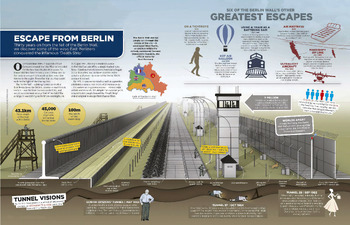The Berlin Wall, an insurmountable divide that bifurcated Germany from 1961 until its fall in 1989, was more than a mere barrier; it symbolized the ideological rift of the Cold War. Would you dare to imagine the lengths to which individuals went to cross this formidable obstruction? For those trapped in East Berlin, escaping to the West demanded not only courage but ingenuity. Here are three fascinating facts shedding light on the myriad ways people orchestrated their furtive exodus from East to West across the Berlin Wall.
1. Ingenious Methods of Concealment and Disguise
One of the most striking characteristics of the escape attempts was the remarkable creativity individuals employed to elude detection. The wall itself became a canvas for resourcefulness, where ordinary items were repurposed into tools for liberation. For instance, some daring escapees fashioned makeshift hot air balloons using bedsheets and propane tanks, with degrees of success varied by the precision of their engineering. Others cleverly transformed everyday bicycles into elaborate contraptions that could navigate the border dimly lit by guards.
Moreover, many escapees utilized disguise as an effective tactic. Some donned fabricated uniforms resembling those worn by East German police or military personnel, enabling them to traverse checkpoints with an illusion of authority. This audacious act of masquerading proved fortuitous, as sometimes ignorance was the best ally against the watchful eyes of those tasked with protecting the stringent border.
Yet, not every attempt was fruitful. The clandestine nature of these escapades often meant that failure could have catastrophic consequences. The fear of reprisal and the stark reality of imprisonment loomed large, igniting a palpable tension in the hearts of those daring enough to challenge the status quo.
2. Underground Tunnels: The Silent Escape Routes
Another extraordinary fact centers around the subterranean labyrinthine tunnels that were painstakingly excavated by East Berliners seeking freedom. These clandestine passages enabled a degree of anonymity not possible above ground. The sheer determination exhibited by those who dug these tunnels is a testament to the lengths individuals would go to flee oppression.
One notable example is the “Tunnel 29,” a 135-meter long passage that became known for its remarkable underground routing. Conceived by a group of intrepid escapees in 1970, this tunnel ultimately allowed approximately 29 individuals to slip through the unyielding grasp of the East German regime. The tunnel’s excavators faced a plethora of hurdles—including the imminent threat of discovery, structural instability, and the perpetual anxiety of whether their plan would indeed succeed.
About 5% of all escape attempts utilized such subterranean strategies. Though the diggers were not instantly recognized as heroes, their bravery and commitment to aiding fellow citizens in their quest for autonomy left an indelible mark on history. The construction of these underground escape routes became a form of civil disobedience, symbolizing hope amidst despair.
3. The Role of Technology: From Smuggled Car Lifts to Small Aircraft
The evolution of technology also played a pivotal role in various escape attempts, with some escapades employing vehicles that defied traditional principles of adventure. Smuggled vehicles, like the ingenious contraptions designed to breach barriers, reflected the tenacity and audacity of those desperate to find their footing on the other side. While some individuals resorted to creating hidden compartments in cars, others sought the audacious assistance of would-be pilots willing to transport them via light aircraft across the heavily patrolled airspace.
One notable case involved a group of brave souls who engaged in an elaborate scheme using a stolen bus that crossed over the border into West Berlin. Although the attempt was met with immediate suspicion, the audacity of commandeering a public transport vehicle underscored a larger narrative woven into the fabric of escape attempts—an insatiable yearning for freedom that propelled individuals to confront danger.
Furthermore, advancements in clandestine technologies, such as two-way radios, enabled escapees to coordinate better with comrades across the wall. These technological innovations contributed not only to enhancing the efficacy of escape attempts but also to the formation of networks dedicated to helping individuals traverse the divide. In hindsight, it seems almost romantic, an undercurrent of bravery and rebellion pulsing through the underground scenes.
Conclusion
The Berlin Wall will forever resonate as a symbol of division; however, the stories of escape are equally significant. The combination of creativity, resilience, and technological ingenuity showcased the undying human spirit. Every attempt, successful or not, revealed a longing for liberty and revealed that even amidst the most oppressive circumstances, hope can flourish against all odds. As we reflect on the ingenuity displayed by those who sought escape, one cannot help but wonder: What lengths would you go to attain your freedom?









